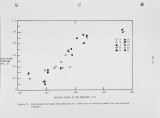| Abstract |
The early results of a comprehensive, systematic, experimental, and review program on alternative liquid fuel combustion, underway at The Pennsylvania State University Fuels and Combustion Laboratory, are reported. The objective is to determine the relationships among alternative liquid fuel compositional properties and flame properties. The paper will focus primarily on the relationship between fuel-bound-nitrogen conversion efficiency and boiling range for coal-derived liquid fuel combustion, as witnessed in a wide variety of combustors [gas turbines, and laboratory, residential, or commercial boilers], and over a wide range of firing rates [0.07 to 570 x 106 Btu/hr], process conditions [COED, SRC-II, Donor Solvent, and H-Coal], fuel properties [blends and separate fractions of neat coal liquid derivatives], and stoichiometrics [± 40% excess air and with/without staging]. The data show that a somewhat dramatic relationship exists between the capacity of a liquid fuel to produce NOX and its boiling range. From an applied combustion viewpoint, the major implication of this information is that the doping of petroleum oils with "traditionally accepted" nitrogenous compounds, such as pyridine and quinoline, does not formulate nitorgen-enriched fuels that can satisfactorily act as surrogates to coal liquid derivatives upon combustion. |































